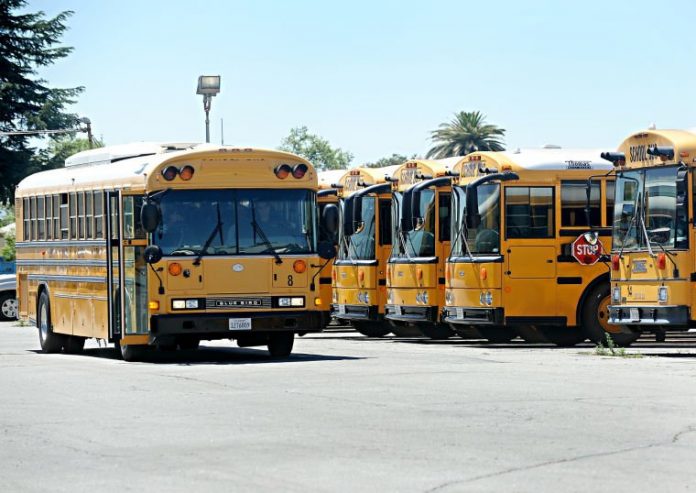
Starting fall 2014, Gilroy Unified School District bus riders will have the chance to hop aboard a converted, $150,000 solar assisted and electric powered school bus.
The bus, unveiled today, May 27 at the district Transportation Department, represents the efforts of at least seven entities and investors on a pilot project hailed by Breathe California president and CEO Margo Sidener as unique for the entire state.
“This is one-of-a-kind for the state of California so far,” Sidener said. “We are hoping to roll this out to many other schools—but this is the first of its kind.”
The Health Trust’s vice president of programs Paul Hepfer said he is excited about the project and seeing more buses like Gilroy’s on the road, “not only because of the tremendous potential a fleet of these buses posses toward reducing asthma in children who ride them daily or live near their routes where they frequent, also because of the creative spirit in which this project was developed.”
“(The project team) came up with a solution that will go a long way in eliminating health disparities of asthma in children and making Silicon Valley the healthiest region in America for everyone,” Hepfer said.
Hepfer spoke about the idea of “disruptive innovation” as a means to help spark replacement of fuel-inefficient bus fleets. By disruptive innovation, he said the project combined nonprofit and for-profit sector partners to “take on the challenge of lowering diesel emissions while dealing with safety and regulatory issues associated with school transportation.”
Dr. Deborah Flores, GUSD superintendent, conveyed the district’s appreciation for being selected to hand over their old diesel bus and get it back as a state-of-the-art converted electric school bus. Gilroy will receive a solar panel array to help generate electricity to fuel the 50-passenger, full-size school bus.
“We are so pleased to be able to help the environment and also to help our budget,” Flores said.
According to Bob Garzee, founder and manager, ETDC and Green Team Leader, the district will save an estimated 80 percent in cost through the electric-powered school bus, cost savings recovered over a five-year period.
An estimated 25 percent of the energy generated for the bus will be solar-assisted. School funding-wise, the bus conversion will not negatively impact maintenance technician staff in the district, who he said would undergo additional training at no cost to the district.
During his speech entitled “Training for New Technology,” Randy Bryant of the Green Transportation Workforce Development and department chair at De Anza Automotive Technology said “mechanics, technicians need not fear this technology,” adding, “because the technology, it’s coming.”
“We believe that to help with implementation you need to have buy-in from your technicians or fleet mechanics, and that will help you greatly in implementation,” Bryant said. “We have some of the best trainers in the state—maybe even the west coast—ready and able to help train your technicians now to help with implementation.”
Ed Monfort is president of ADOMANI Electric, the group who designed the system. The inventor of the bus conversion cited the safety, cost-effectiveness of the project and “realistic” return on investment.
“A lot of the ADOMANI investors really put a lot of money into this,” Monfort said. “This is not an easy technology to develop, but I’m telling you what I have right now, we’re well on our way, and there’s a lot of companies looking at us right now … ”
Monfort said the redundancies inherent throughout the bus mechanics create efficiency, adding that he utilized aerospace connections and technologies.
“I’ve separated all of the batteries to where it’s very safe,” Monfort said, “way safer than a Tesla any day, I can assure you of that.”
The new school bus will first have demonstrations before going full-time in GUSD and start its routes beginning in fall of 2014, according Sidener, who said data will be collected on the pilot project to provide how “everybody wins” by displacing “dirty diesel buses” with “clean economically fueled ones.”
“It’s very economical,” Sidener said, “especially for school districts with huge solar arrays.”
Gilroy was selected for the project because The Health Trust wanted to serve Gilroy, and the school district fit the parameters of having a sizable bus fleet that “would go many miles.”
Hepfer said his group is excited to support GUSD and Breathe California in the “cutting edge approach to school transportation as a means of addressing disparities in health outcomes.”
Those in attendance included representatives from the offices of Congressman Sam Farr and State Assemblyman Luis Alejo, Gilroy Mayor Don Gage, CH Reynolds and Green Transportation Workforce Development.












